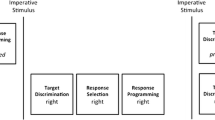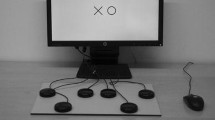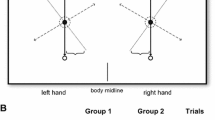Abstract
Symmetric, target-directed, bimanual movements take less time to prepare than asymmetric movements (Diedrichsen et al. in Cerebral Cortex 16(12):1729–1738, 2006; Heuer and Klein in Psychol Res 70(4):229–244, 2006b). The preparation savings for symmetric movements may be related to the specification of symmetric amplitudes, target locations, or both. The goals of this study were to determine which symmetric movement parameters facilitate the preparation of bimanual movements and to compare the size of the facilitation for different parameters. Thirty participants performed bimanual reaching movements that varied in terms of the symmetry/asymmetry of starting locations, movement amplitudes, and target locations. Reaction time savings were examined by comparing movements that had one symmetric parameter (and two asymmetric parameters) to movements with all asymmetric parameters. We observed significant savings (~10 ms) for movements with symmetric amplitudes and movements with symmetric target locations. Reaction time costs were examined by comparing movements that had two asymmetric parameters (and one symmetric parameter) to movements with all symmetric parameters. We observed significant reaction time costs (~13 ms) for all movements with asymmetric amplitudes. These results suggest that movement preparation is facilitated when amplitudes or target locations are symmetric and that movement preparation suffers interference when amplitudes are asymmetric. The relative importance of the three parameters to movement preparation, from most to least important, is movement amplitudes, target locations, and then starting locations. Interference with asymmetric amplitudes or target locations may be caused by cross-talk between concurrent processes of parameter specification during response programming.





Similar content being viewed by others
Notes
Statistically, it does not make a difference whether we analyse the RT savings [(SaT, sAT, SAt)—SAT] or the RTs (SaT, sAT, SAt). Subtracting SAT from the RTs to calculate the RT savings affects the participant variance but neither the treatment variance nor the error variance. The results of these analyses are identical because repeated measures ANOVAs disregard the participant variance. The variances that are used are the treatment and error variances and these are identical in both calculations. Therefore, analysis of the RTs allowed us to make inferences about the relative RT savings.
References
Blinch, J., Cameron, B. D., Cressman, E. K., Franks, I. M., Carpenter, M. G., & Chua, R. (2014). Comparing movement preparation of unimanual, bimanual symmetric, and bimanual asymmetric movements. Experimental Brain Research, 232(3), 947–955.
Blinch, J., Franks, I. M., Chua, R. (2013). Eliminating the preparation cost for bimanual asymmetric movements. Poster presented at the biannual meeting of Progress in Motor Control, Montreal, QC.
Diedrichsen, J., Grafton, S., Albert, N., Hazeltine, E., & Ivry, R. B. (2006). Goal-selection and movement-related conflict during bimanual reaching movements. Cerebral Cortex, 16(12), 1729–1738.
Diedrichsen, J., Hazeltine, E., Kennerley, S., & Ivry, R. B. (2001). Moving to directly cued locations abolishes spatial interference during bimanual actions. Psychological Science, 12(6), 493–498.
Donders, F. C. (1969). On the speed of mental processes. Acta Psychologica, 30, 412–431.
Favilla, M. (1996). Reaching movements: programming time course is independent of choice number. NeuroReport, 7(15–17), 2629–2634.
Franz, E. A., & McCormick, R. (2010). Conceptual unifying constraints override sensorimotor interference during anticipatory control of bimanual actions. Experimental Brain Research, 205(2), 273–282.
Franz, E. A., Zelaznik, H. N., Swinnen, S. S., & Walter, C. (2001). Spatial conceptual influences on the coordination of bimanual actions: when a dual task becomes a single task. Journal of Motor Behavior, 33(1), 103–112.
Heuer, H. (1986). Intermanual interactions during programming of finger movements: Transient effects of ‘homologous coupling’. In H. Heuer & C. Fromm (Eds.), Generation and modulation of action patterns (pp. 87–101). Berlin: Springer.
Heuer, H. (1993). Structural constraints on bimanual movements. Psychological Research, 55(2), 83–98.
Heuer, H. (2006). Simultaneous specification of amplitudes and directions of bimanual reversal movements. Journal of Motor Behaviour, 38(4), 285–298.
Heuer, H., & Klein, W. (2006a). Intermanual interactions related to movement amplitudes and endpoint locations. Journal of Motor Behavior, 38(2), 126–138.
Heuer, H., & Klein, W. (2006b). The influence of movement cues on intermanual interactions. Psychological Research, 70(4), 229–244.
Heuer, H., & Klein, W. (2006c). The modulation of intermanual interactions during the specification of the directions of bimanual movements. Experimental Brain Research, 169(2), 162–181.
Heuer, H., Spijkers, W., Kleinsorge, T., van der Loo, H., & Steglich, C. (1998). The time course of cross-talk during the simultaneous specification of movement amplitudes. Experimental Brain Research, 118(3), 381–392.
Hick, W. E. (1952). On the rate of gain of information. Quarterly Journal of Experimental Psychology, 4(1), 11–26.
Huynh, H., & Feldt, L. S. (1976). Estimation of the box correction for degrees of freedom from sample data in randomized block and split-plot designs. Journal of Educational Statistics, 1(1), 69–82.
Hyman, R. (1953). Stimulus information as a determinant of reaction time. Journal of Experimental Psychology, 45(3), 188–196.
Kelso, J. A., Southard, D. L., & Goodman, D. (1979). On the coordination of two-handed movements. Journal of Experimental Psychology: Human Perception and Performance, 5(2), 229–238.
Kovacs, A. J., Buchanan, J. J., & Shea, C. H. (2009). Bimanual 1:1 with 90 degrees continuous relative phase: difficult or easy! Experimental Brain Research, 193(1), 129–136.
Marteniuk, R. G., MacKenzie, C. L., & Baba, D. M. (1984). Bimanual movement control: Information processing and interaction effects. Quarterly Journal of Experimental Psychology, 36(A), 335–365.
Spijkers, W., Heuer, H., Kleinsorge, T., & van der Loo, H. (1997). Preparation of bimanual movements with same and different amplitudes: specification interference as revealed by reaction time. Acta Psychologica, 96(3), 207–227.
Stelmach, G. E., Amrhein, P. C., & Goggin, N. L. (1988). Age differences in bimanual coordination. Journal of Gerontology, 43(1), 18–23.
Sternberg, S. (1969). The discovery of processing stages: Extension of Donders’ method. In W. G. Koster (Ed.), Attention and Performance II (pp. 276-315). Amsterdam: North-Holland.
Swinnen, S. P., Lee, T. D., Verschueren, S., Serrien, D. J., & Bogaerds, H. (1997). Interlimb coordination: learning and transfer under different feedback conditions. Human Movement Science, 16(6), 749–785.
Swinnen, S. P., & Wenderoth, N. (2004). Two hands, one brain: cognitive neuroscience of bimanual skill. Trends in Cognitive Sciences, 8(1), 18–25.
Weigelt, M. (2007). Re-examining structural constraints on the initiation of bimanual movements: the roles of starting locations, movement amplitudes, and target locations. Human Movement Science, 26(2), 212–225.
Weigelt, C., & Cardoso de Oliveira, S. (2003). Visuomotor transformations affect bimanual coupling. Experimental Brain Research, 148(4), 439–450.
Wenderoth, N., & Weigelt, M. (2009). Visual cues influence motor coordination: behavioral results and potential neural mechanisms mediating perception-action coupling and response selection. Progress in Brain Research, 174, 179–188.
White, O., & Diedrichsen, J. (2010). Responsibility assignment in redundant systems. Current Biology, 20(14), 1290–1295.
Wright, C. E., Marino, V. F., Belovsky, S. A., & Chubb, C. (2007). Visually guided, aimed movements can be unaffected by stimulus-response uncertainty. Experimental Brain Research, 179(3), 475–496.
Acknowledgements
We would like to thank Associate Editor Peter Q Pfordresher and two anonymous reviewers for their insightful critiques. We would also like to thank Brandon Rasman, Kathryn Clark, and Curtis May for their help with participant recruitment and data collection. The Natural Sciences and Engineering Research Council of Canada supported this research with a postgraduate scholarship awarded to Jarrod Blinch and a discovery grant awarded to Romeo Chua. Brendan Cameron was supported by a Juan de la Cierva postdoctoral fellowship (JCI-2011-09664) and a Marie Curie CIG (618407). The views expressed here reflect those of the authors only and not those of the funders.
Author information
Authors and Affiliations
Corresponding author
Rights and permissions
About this article
Cite this article
Blinch, J., Cameron, B.D., Franks, I.M. et al. Facilitation and interference during the preparation of bimanual movements: contributions from starting locations, movement amplitudes, and target locations. Psychological Research 79, 978–988 (2015). https://doi.org/10.1007/s00426-014-0624-y
Received:
Accepted:
Published:
Issue Date:
DOI: https://doi.org/10.1007/s00426-014-0624-y




